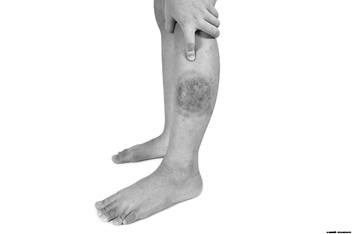Ringworm of the Body (Tinea Corporis)

Tinea corporis is also called ringworm of the body, but it’s not caused by a worm. It’s a fungus infection. A fungus is a germ that’s too small to see. It gets its name from the ring or circle it makes on the body.
Ringworm is contagious. That means it spreads easily. A child can get it when their skin comes in contact with:
- The rash of a person who has it.
- An object used by an infected person.
- An infected animal, like a dog, kitten, or rodent.
Signs and Symptoms
- Ringworm starts as a rash with tiny red pimples. The pimples slowly spread and form a ½- to 1-inch round or oval ring.
- The ring’s edges are red, raised, or scaly.
- The skin inside the ring may look pink or almost normal.
- The rash usually appears in only a few places on the skin, but it may occur anywhere on the body and may itch.
- Ringworm doesn’t usually cause serious problems.
Diagnosis
The doctor or health care provider will diagnose ringworm based on your child’s health history and by looking at the rash. Sometimes they will scrape a few scales of skin from the ring and send it for testing.
Treatment
A single patch of ringworm can be treated with an over-the-counter (OTC) antifungal cream. Creams usually contain clotrimazole, ketoconazole, econazole, tolnaftate, or terbinafine. If there are many patchy areas, your child may need a prescription cream, or oral antifungal medicine taken by mouth.
- Read the medicine label or ask your doctor or pharmacist if the cream you choose is safe for your child.
- Ask how often the cream should be applied and for how many days. Usually, treatment is for 4 weeks or 2 weeks after the skin lesion goes away.
- Athletes, like wrestlers, with tinea corporis can take part in matches 72 hours after starting treatment and when the area can be covered.
- Ringworm usually goes away within 4 weeks of treatment. Your child can return to daycare or school after starting treatment.
How to Put on the Antifungal Cream
- Wash and dry your hands.

- Wash the rash with soap and water in a bathtub, bathroom sink, or pan. Do not use a kitchen sink to wash the rash.
- Dry the rash completely with a paper towel or clean cloth towel. Do not touch skin that is not infected with this towel. If a cloth towel is used, wash it before using again.
- Apply a thin layer of cream just past the outside edges of the rash.
- Spread the cream, beginning from the outside area first, then move toward the center of the rash (Picture 1).
- Do not cover the ringworm with a bandage.
- Wash and dry your hands well.
How to Prevent Ringworm
The fungus grows well on warm, dark, moist areas of the body. To prevent ringworm from spreading to others:
- Keep your child’s skin clean and dry. Dry their skin well after washing or bathing.
- Anyone that touches a ringworm rash, must wash their hands well and right away.
- Wear clean clothes and change socks and underwear each day.
- Don’t let your child share clothes, towels, stuffed toys, or personal items like brushes, combs, and barrettes with others.
- Wash and dry clothing and towels that have touched the rash. Use the hottest setting allowed on the care labels.
- Wash the bathtub, bathroom sink, or pan well after each use.
- Wash hands after playing with any animals. Check pets for ringworm and get them treated if needed.
- Wear shoes, like flip-flops, in locker rooms and in public showers.
- Shower right away after all contact sports, like wrestling and football.
When to Call the Doctor
Call your child’s doctor or health care provider if the rash:
- Gets worse and shows signs of infection, like pus, swelling, or drainage.
- Does not seem to be healing after 2 weeks.
- Has not fully healed after 4 weeks.
HH-I-143 • ©1991, revised 2023 • Nationwide Children's Hospital

